You’re never too young to get involved with forest schools!
Toddlers can learn huge amounts in simple outdoor forest environments.
I’ve been teaching in forest schools over the course of the last ten years on and off, and in that time I’ve found some real gems of activities that work perfectly for toddlers.
In this post, I’ll talk you through how to carry out all of these. These ideas are all really simple to carry out, and most of them the children can do independently, and learn in the way they do best…through play.
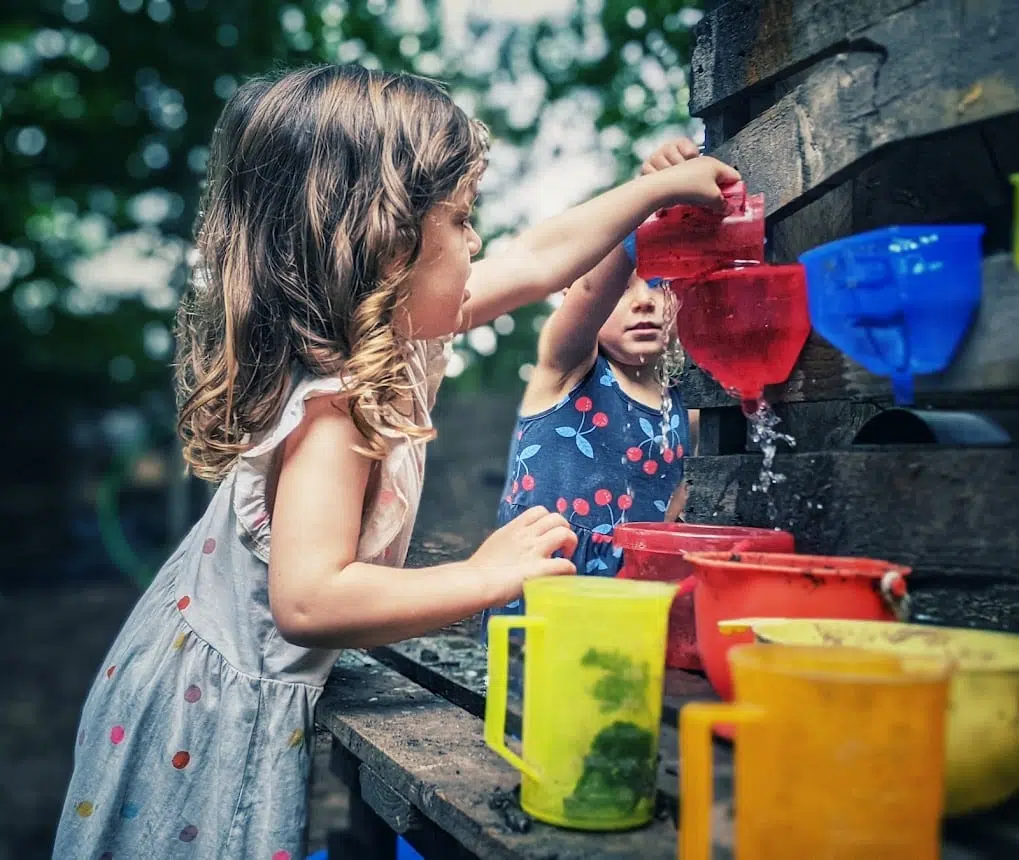
1. Music Walls
These are pretty simple to set up (honestly!)
Even very slight DIY skills will be enough. And there are multiple ways you can set up a music wall.
The basic idea is to attach objects that make a noise to a wall or fence of some sort. Music walls I have seen and like include:
Attach some pallets to a wall
Then you can connect musical or noisy objects to the pallet. Some ideas might be a colander, a xylophone, pots and pans, and chime bars.
It makes sense to have something to play them with that is connected to the wall as well. Something like wooden spoons attached to the pallet with string would work well.
Large drums or barrels
I saw this at an outdoor school recently, and it’s one of my favorite outdoor music areas.
You basically get lots of barrels, or oil drums, and tie them together with rope (so they’re not going anywhere). Then attach some spoons or other beaters to the barrels with string or rope.
You can also hit them with sticks.
The barrels I saw were all different sizes, so they all had a different musical tone.
Kitchen Utensils suspended from a string
Here’s a great one for all you DIY haters out there.
All you need to do is get a long piece of string suspended between two trees and dangle metal kitchen equipment from it. Things like pots, colanders, spoons, ladles, and all that kind of thing. Hit the equipment with the spoons and ladles.
It won’t sound all that musical! But the idea is that kids are discriminating sounds. It’s all part of the long process that makes up listening and early phonics.
2. Mud Hedgehogs
Let’s go onto possibly the most exciting…the ooziest…the gloopiest…the sludgiest substance out there in the world today…mud!
Kids love it, and quite right too.
To make a hedgehog…
Make a body of the hedgehog out of a big dollop of mud! Getting the consistency of the mud right is probably the biggest challenge to start with. Mix earth and water to the right consistency (firm mud, and not too oozy or sloppy).
Then get a big ball of mud for the body!
Now the activity is like a scavenger hunt. Basically, the kids are going to walk around outside and look for objects to make the prickles, eyes, and any other features they want on their hedgehog.
Twigs are great for prickles! You can also try flowers or nuts for the eyes.
Here’s a fantastic example of what one might look like:
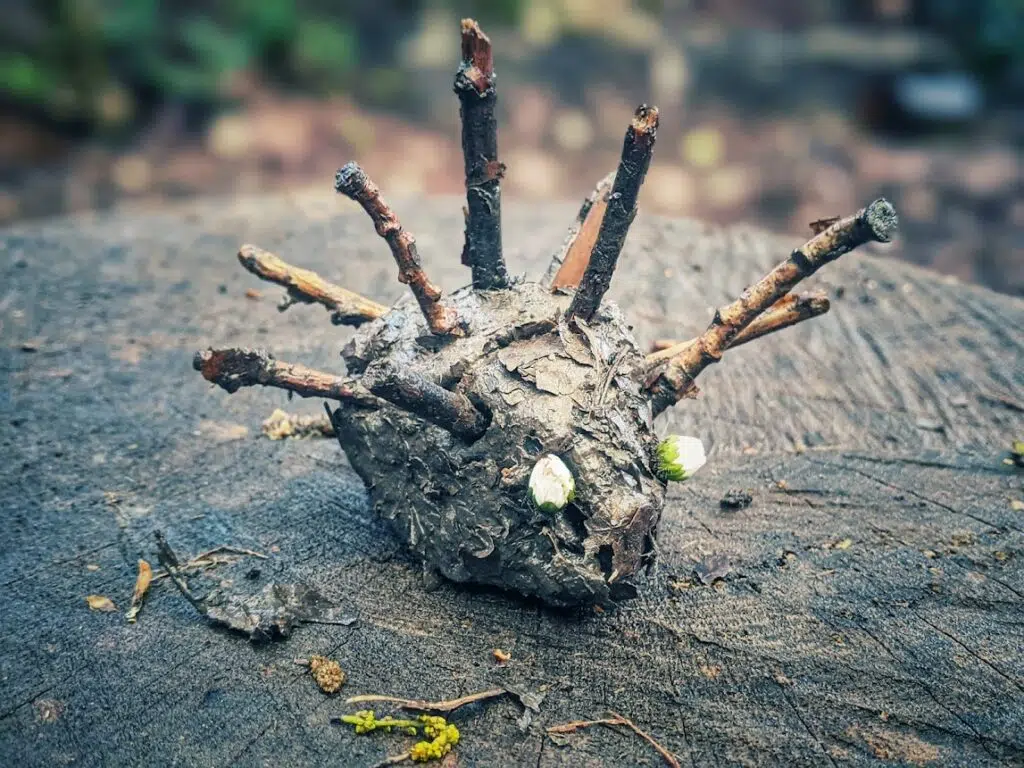
3. Natural Picture Frames
Transient art is a great favorite of outdoor forest school learning. (Source)
And you can definitely have a go of this with toddlers.
To start with, you need some kind of frame. I tried this, by creating paper frames, with plants and natural objects glued around the outside.
They looked like this:
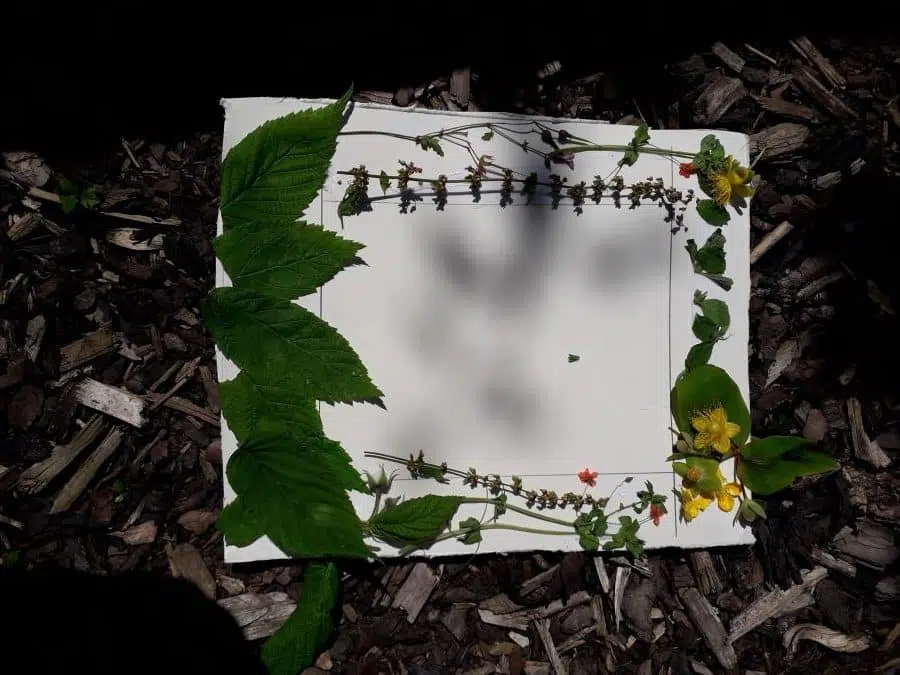
The idea is that the kids take these frames, and find objects to place on the frames.
Again, you’re looking for plants, leaves, flowers, nuts, and whatever else you can find – all placed together to make a super transient art picture.
4. Rope Swings
If you are lucky enough to have any trees, then setting up a rope swing of some sort is definitely the way to go.
Probably the easiest to access for toddlers is a tire swing. Just suspend a tire very low to the ground on a short rope from a strong branch.

Young kids even enjoy just pushing a tire swing (even if they can’t actually get onto it very well). You will also see some of them pushing toys (like a bear) in the swing, or pushing their friends.
Some will be able to access it, and they can swing in the tire. Rope swings are particularly good for children that demonstrate a rotation schema – an interest in looking at the world from a different perspective.
5. Hammocks
Simple hammocks are another resource that can be set up reasonably easily, but that offer huge amounts of learning.
Also, once you’ve set them up, they’ll last for a very long time.
You can hang hammocks in between two adjoining trees. If you haven’t got any suitable trees, I have also seen them hanging between fences (near the corner), or from posts.
Toddlers can access hammocks in a variety of ways.
You will see them lying in them, covering themselves completely in the material.
Or they might push their friends or even a cuddly toy.
Hammocks are a great place to relax, reflect, and think.
6. Mud Kitchen
These are a fantastic resource for toddlers in a forest school!
All mud kitchens look different, but the main thing is to include at least some of the following:
- Some kind of surface to create ‘food’ and potions!
- Lots of pots and pans
- Kitchen utensils like ladles and spoons
- Bowls and cutlery
- A source of water
- A source of mud!
- A pestle and mortar
Kids love making dinners, magic spells, and all sorts of other things. These areas are great for all kinds of schema play, for pouring and tipping, emptying, filling, mixing, transforming, and a whole host of other skills.
7. Pouring Down Gutters/Tubes
Having a selection of simple tubes or gutters in the environment will get a lot of use!
I often ask parents to bring in any bits of plumbing that they have available.
Kids love pouring all sorts of things down them, such as:
- Water
- Earth
- Balls
- Cars
- Leaves
You can attach gutters and tubes to fences, or to walls, or even to trees.
8. Forest Bathing
This is very fashionable these days.
Forest bathing is a beautiful mindful experience. The idea is to stand barefoot in a forest setting. You walk or stand on all different kinds of textures:
- Moss
- Mud!
- Earth
- Grass
- In leaves
- On rocks
In different temperatures, these all have a different feel. For example, in winter moss might be crunchy, and bitingly cold. In summer, it might be fluffy.
Forest bathing is probably best done sitting for toddlers. Just all take your shoes or boots and socks off, and then place your feet in different substances.
You can talk about how it feels, but the true essence of forest bathing is the experience itself. You want to feel the grassiness of grass, and the leafiness of leaves.
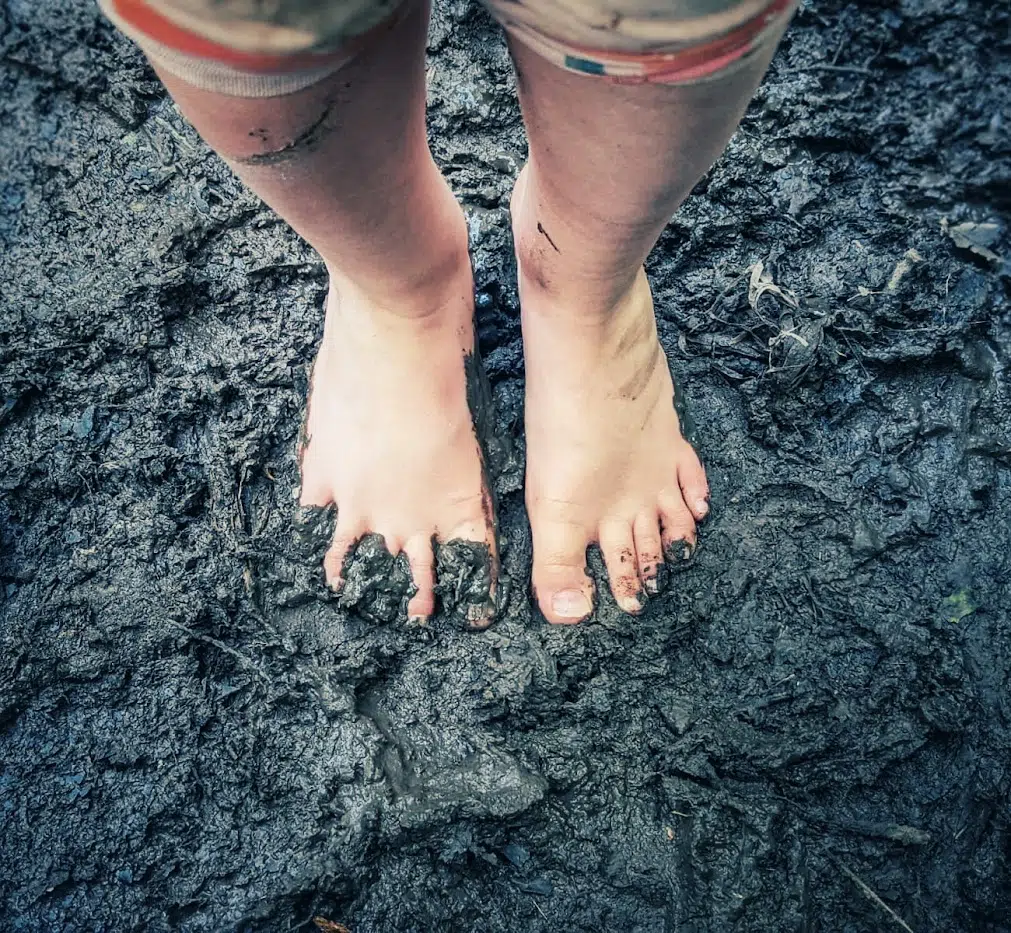
9. Sheltering In Dens
Den-building is one of the ultimate forest school learning activities, and it is definitely one that is open to toddlers to explore.
Try simple den-building with toddlers and adults together, such as placing branches over each other to make a stick den that looks like this:
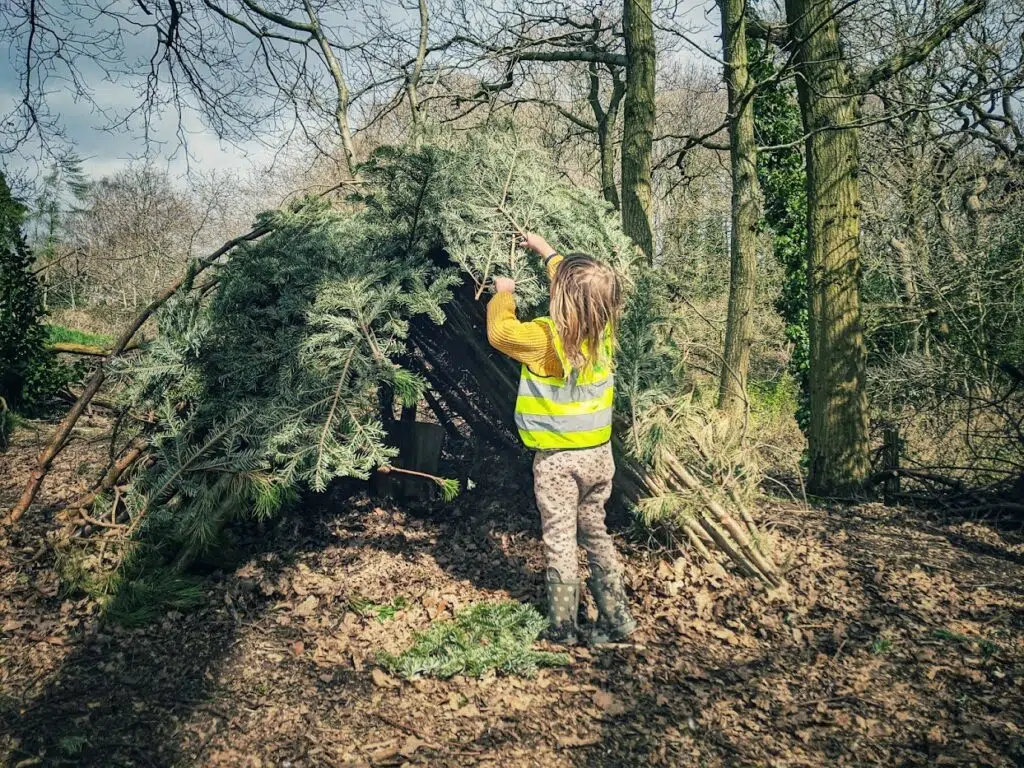
Even children that aren’t interested in the actual creation of a den, are often fascinated by using it when it’s built.
Dens provide that feeling of security and enclosure.
They are brilliant for children that demonstrate an enclosure schema – an interest in being surrounded.
They are also a place for reflection and momentary solitude.
10. Mud Slides
This is not one to be undertaken lightly!
First a warning – you need full-on good quality waterproof clothing for all the kids before you try this out.
You also need some kind of small slope or little hill in your environment that you don’t mind turning permanently into a mudslide. That’s right – this is a permanent thing! Once this slope becomes a mud-slide, there’s pretty much no way back!
To make a hillside, select your slope, and then put a hosepipe at the top. You need to really soak the slope.
Then get the kids to trample and roll down the hill!
Even if it’s lush green with grass to start with, it will start to get a bit muddier over time.
After a few sessions, it will be a full-blown mudslide, transporting them all down the hill at the greatest speed!
But what do they learn from this!? Lots of things, including:
- Experiencing a sense of risk
- Experiencing speed
- Developing gross motor abilities
- Developing confidence and even bravery
11. Obstacle Courses
Toddlers can make their own obstacle courses with just a very few simple resources.
I like to use outdoor loose parts. Supply a few of the following:
- Planks
- Sticks
- Crates
- Log slices
- Old sacks
- Tires
Kids can rearrange these in all sorts of ways. It works particularly well if you have a muddy area. Children really like building walkways over mud.
12. Raking Leaves/Brushing
A bit of gardening is always fun!
And many kids love some simple gardening actions. Raking leaves is a popular one. They can also transport the leaves to other areas.
Some children just enjoy throwing leaves (a scattering schema).
Brushing stones or leaves also has lots of learning benefits.
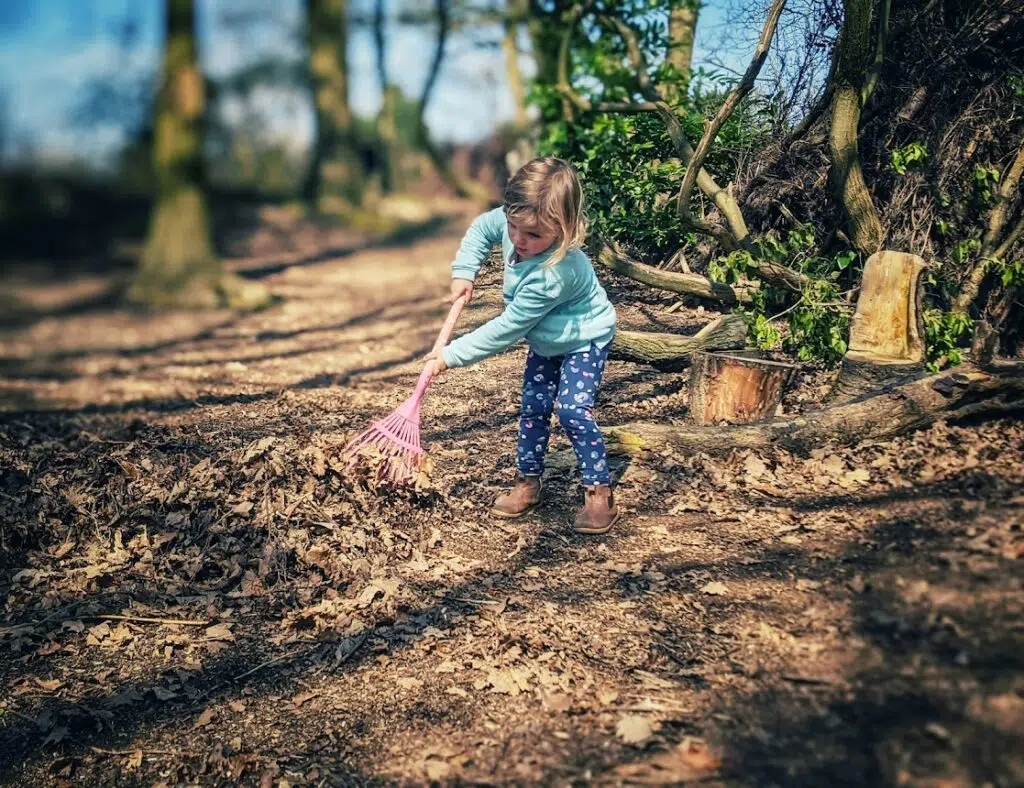
13. Using A Trolley
Many kids have that natural instinct to transport objects around the environment.
This is called a transporting schema and is one of the most common types of schema play.
A simple DIY trolley is a great addition to the outdoor environment. Some kind of wooden base on wheels, with a piece of rope attached, is all you need! DIYers get to work.
You will often see them transporting:
- Soil
- Water
- Leaves
- Bark
- Stones
14. A Range Of Containers
This is super simple! But by simply having lots of pots and pans, or different buckets – all sorts of learning will take place!
Children love to transport objects all around the environment.
They will be pouring water on the ground and creating little rivers. Or piling bark into pots to make potions.
15. Fire Pit
Some kind of communal gathering is integral to forest school sessions.
This traditionally happens around a ‘fire pit’. The fire pit is a natural seating area, around some kind of area where a fire could potentially be lit (if you are trained and insured to do this).
Fire pits without an actual fire are a good option also for communal gatherings.
Some kind of natural seating works well. You could use:
- Wood slices
- Logs
- Pieces of decking
- Tree stumps
Fire-pit activities include:
- Singing songs
- Talking about what we see or hear
- Reading stories
- Circle time games
Final Thoughts
You’re definitely never too young to get involved in forest school, and toddlers can access a huge number of learning activities.
If you’ve found this article useful, then another that you’ll enjoy is all the best forest school superhero activities, which you can find here.
